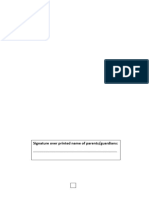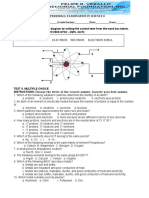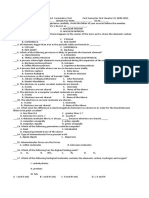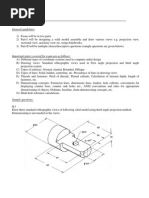SUMMATIVE TEST No.4
SUMMATIVE TEST No.4
Uploaded by
hvnhvn.vnCopyright:
Available Formats
SUMMATIVE TEST No.4
SUMMATIVE TEST No.4
Uploaded by
hvnhvn.vnOriginal Title
Copyright
Available Formats
Share this document
Did you find this document useful?
Is this content inappropriate?
Copyright:
Available Formats
SUMMATIVE TEST No.4
SUMMATIVE TEST No.4
Uploaded by
hvnhvn.vnCopyright:
Available Formats
Answer directly on this
test paper.
Republic of the Philippines
Department of Education
REGION VII – CENTRAL VISAYAS
SCHOOLS DIVISION OF MANDAUE CITY
LABOGON NATIONAL HIGH SCHOOL
Q3-SUMMATIVE TEST 4
Name: __________________________ Grade and Section: _______________________ Date: ______________
Direction: Write the LETTER of the correct answer on the SPACE provided before the number.
_______1. Who first coined the term atom, meaning indivisible?
A. Democritus B. Dalton C. Rutherford D. Thomson
_______2. Thomson is responsible for discovering that an atom contains ___________.
A. anodes B. electrons C. molecules. D. a nucleus
_______3. The charge of an atom is ________.
A. negative B. neutral C. positive D. unbalanced
_______4. Which of the following was the instrument used for the discovery of the electron?
A. Cathode ray tube C. Alpha particle emitter
B. Gold foil experiment D. Oil drop apparatus
_______5. In ____________ atomic model, negative electrons orbit the positively charged nucleus.
A. Dalton’s B. Democritus c. Rutherford’s D. Thomson’s
_______6. Whose model suggested that negative particles were mixed in with positively charged material
- like seeds in a watermelon?
A. Democritus B. Dalton C. Rutherford D. Thomson
_______7. Which of the following statements are TRUE about the properties of subatomic particles?
I. The neutron has no charge.
II. The proton is positively charged.
III. The electron is negatively charged.
IV. The neutron has both positive and negative charge.
A. I, II, IV B. I, III, IV C. I, II, III D. II, III, IV
_______8. What did Rutherford learn about the atom in the gold-foil experiment?
A. Atoms have electrons.
B. Atoms have a nucleus.
C. The nucleus is most of the atom’s volume.
D. Atoms have negative charge embedded in a sphere of positive charge.
_______9. According to James Chadwick, neutrons are present in the nucleus of all atoms except ____.
A. Boron B. Carbon C. Hydrogen D. Oxygen
_______10. Which of these statements best describes the Plum Pudding model?
A. Atoms are made up of tiny particles.
B. Atoms are solid indivisible balls of matter.
C. Atoms are balls of positive charge with negatively charged electrons spread throughout.
D. Atoms consist of a small positively charged nucleus surrounded by a cloud of negatively
charged electrons.
________11. What is an atom’s nucleus made of?
A. protons and neutrons C. only neutrons
B. protons and electrons D. only protons
________12. What model represents the features of the following atomic structure?
I. It has a tiny, dense positively charged core
II. Mass is concentrated at the center
III. Atom has a tiny and heavy nucleus
IV. The negative constituent called electron circulates around the nucleus
A. B. C. D.
________13. What is the key idea of Bohr’s model?
A. The atom is like a raisin bread.
B. It explains that there is a nucleus.
C. It explains that an atom is hard to see with the naked eye.
D. There are electrons inside the atom that orbit the nucleus.
________14. Nickel (Ni) has five naturally occurring isotopes. Which of the following describes the
relationship of these isotopes?
A. They have different masses and different atomic numbers.
B. They have different masses but the same atomic numbers.
C. They have the same masses but different atomic numbers.
D. They have the same masses and the same atomic numbers.
________15. Investigate which specie with the characteristics shown on the table corresponds to
the stable isotope of Aluminum (Al-27).
Specie Proton Neutron Atomic Mass
number number number number
M1 13 14 13 27
M2 13 14 13 26
M3 13 13 13 26
M4 13 10 13 23
M5 13 17 13 30
A. M1 & M2 B. M1 only C. M3 & M4 D. M4 only
________16. In a correctly written symbol what would be in the "A" position?
A. mass number
B. atomic number
C. number of neutrons
D. number of electrons
________17. What is the mass number of an element that has 19 protons, 19 electrons, and 20 neutrons?
A. 19 B. 20 C. 39 D. 58
________18. A certain atom has 26 protons, 26 electrons, and 30 neutrons. Its mass number is ____.
A. 26 B. 30 C. 52 D. 56
________19. A beryllium atom has 4 protons, 5 neutrons, and 4 electrons. What is the mass number of
this atom?
A. 4 B. 5 C. 8 D. 9
________20. Oxygen’s atomic number is 8. This means that an oxygen atom has
A. eight neutrons in its nucleus. C. a total of eight protons and neutrons.
B. eight protons in its nucleus. D. a total of eight neutrons and electron
__________________________________________ ______________________________________
Signature over Printed Name Parent’s Signature over Printed Name
You might also like
- Grade 8 ReviewerDocument2 pagesGrade 8 ReviewerEunice CorreaNo ratings yet
- Third Long Test Grade 8 Science: Gen. Ricardo Papa Sr. Memorial High SchoolDocument2 pagesThird Long Test Grade 8 Science: Gen. Ricardo Papa Sr. Memorial High SchoolEunice CorreaNo ratings yet
- 16 - Chapter Summative TestDocument2 pages16 - Chapter Summative TestDASH OBISPONo ratings yet
- second quarter Exam in science 9 arrangedDocument9 pagessecond quarter Exam in science 9 arrangedRhode Faith BerjaNo ratings yet
- TOS and TQ For Third Quarter Sci8Document5 pagesTOS and TQ For Third Quarter Sci8Yeng Camila BarceNo ratings yet
- Grade 8 Science TQDocument2 pagesGrade 8 Science TQAngel DPNo ratings yet
- GRADE-8-THIRD-QUARTER-EXAMDocument5 pagesGRADE-8-THIRD-QUARTER-EXAMMelodina AcainNo ratings yet
- Science 9 PT 2ndQDocument3 pagesScience 9 PT 2ndQMaria Elaine Feranil100% (1)
- 3rd Summative ExamsDocument3 pages3rd Summative ExamsK Ri NgNo ratings yet
- Quiz 4Document2 pagesQuiz 4Karymae AkasNo ratings yet
- San Roque National High SchoolDocument3 pagesSan Roque National High SchoolEvangelene Esquillo SanaNo ratings yet
- 3rd and 4th Summative TestDocument7 pages3rd and 4th Summative TestAnn OldanNo ratings yet
- Science 8 ST3Document2 pagesScience 8 ST3Alvin GultiaNo ratings yet
- Sci.9 Weeks 1Document2 pagesSci.9 Weeks 1Jaime CrispinoNo ratings yet
- Sci.9 Weeks 1-2Document2 pagesSci.9 Weeks 1-2Jaime CrispinoNo ratings yet
- 2nd SUM TESTDocument4 pages2nd SUM TESTCatherine De LunaNo ratings yet
- Quiz 5 Atoms, Atomic Theory, Atomic StructureDocument4 pagesQuiz 5 Atoms, Atomic Theory, Atomic StructureJoeylyn BalidioNo ratings yet
- g8 Science Third Periodical ExamDocument2 pagesg8 Science Third Periodical ExamGlaiza Mapute Caringal100% (1)
- Chapter 8 Revision Modified MDocument22 pagesChapter 8 Revision Modified Mخالد الغامديNo ratings yet
- Letran de Davao, Inc.: High School DepartmentDocument2 pagesLetran de Davao, Inc.: High School DepartmentappleNo ratings yet
- Third Quarter Examination in Science 8: Inopacan National High SchoolDocument4 pagesThird Quarter Examination in Science 8: Inopacan National High SchoolR-Yel Labrador BaguioNo ratings yet
- Answer SheetDocument8 pagesAnswer SheetGwyn CervantesNo ratings yet
- Answer Sheet (Janelle)Document8 pagesAnswer Sheet (Janelle)Gwyn CervantesNo ratings yet
- Science 8 3rd Grading ExamDocument3 pagesScience 8 3rd Grading ExamJon Mitchel GalangNo ratings yet
- LONG TEST in PHYSCIAL SCIENCE2Document3 pagesLONG TEST in PHYSCIAL SCIENCE2Jeanine CristobalNo ratings yet
- Grade 8 Science 3rd QuarterDocument2 pagesGrade 8 Science 3rd Quartergerald quijanoNo ratings yet
- Diagnostic Test in PhySciDocument4 pagesDiagnostic Test in PhySciJuliane Rebecca PitlongayNo ratings yet
- Q3 REMEDIATION Final Edited 2Document3 pagesQ3 REMEDIATION Final Edited 2Athena ChoNo ratings yet
- Starr 02 - 03Document18 pagesStarr 02 - 03John EspiqueNo ratings yet
- 2nd PERIODICAL Test Science 9 - Q2Document8 pages2nd PERIODICAL Test Science 9 - Q2katherinejoy.cruzNo ratings yet
- Summative Assessment 1 2nd QuarterDocument2 pagesSummative Assessment 1 2nd QuarterJudith DurensNo ratings yet
- Periodic Test_Science 9_Q2Document7 pagesPeriodic Test_Science 9_Q2amelia.engreso29No ratings yet
- Quiz 3Document2 pagesQuiz 3Karymae AkasNo ratings yet
- atom.rtfDocument4 pagesatom.rtfpwrq150No ratings yet
- Quarter 2 - Periodical Test - Science 9Document7 pagesQuarter 2 - Periodical Test - Science 9Christian Layson Labastida100% (1)
- 2 Periodical Exam in Science 9: InstructionDocument3 pages2 Periodical Exam in Science 9: InstructionmontesjessiebajadoNo ratings yet
- HONORS Chapter 5 Test 2010 PDFDocument13 pagesHONORS Chapter 5 Test 2010 PDFAnonymous QfYZQy0% (1)
- Second Periodic Test ScienceDocument4 pagesSecond Periodic Test ScienceChai BarcelonNo ratings yet
- Final 3rd Quarter Exam 2022-2023Document4 pagesFinal 3rd Quarter Exam 2022-2023Karymae AkasNo ratings yet
- Unit 1: Chemistry Review: "Practice Test"Document8 pagesUnit 1: Chemistry Review: "Practice Test"Anthony SisonNo ratings yet
- Unit 3 Test ADocument6 pagesUnit 3 Test AGoldyn FordNo ratings yet
- Holy Child Montessori School of Bulacan Inc. 3 Quarterly Test Physical ScienceDocument5 pagesHoly Child Montessori School of Bulacan Inc. 3 Quarterly Test Physical ScienceDivina NicolasNo ratings yet
- Chapter 4 Practice Test NewDocument8 pagesChapter 4 Practice Test Newrwin2024No ratings yet
- Science 8 Third Quarter ExamDocument3 pagesScience 8 Third Quarter ExamArgel Quilab LarongcoNo ratings yet
- Unit TestDocument3 pagesUnit TestRenalyn F. AndresNo ratings yet
- Second Quarter G9 TestDocument3 pagesSecond Quarter G9 TestbryanNo ratings yet
- finalGENERAL CHEMISTRYprelim EXAMINATION 1STDocument4 pagesfinalGENERAL CHEMISTRYprelim EXAMINATION 1STSijey ManingasNo ratings yet
- SCH3U Chemistry Unit 1 MC ReviewDocument16 pagesSCH3U Chemistry Unit 1 MC Review1moeezafNo ratings yet
- Test For AteDocument4 pagesTest For AteZyra Barbin MaglabeNo ratings yet
- Physical ScienceDocument4 pagesPhysical ScienceCleo Dehino100% (1)
- 3rdGENERAL CHEMISTRYprelim EXAMINATION 1STDocument3 pages3rdGENERAL CHEMISTRYprelim EXAMINATION 1STSijey ManingasNo ratings yet
- Phy Sci 1st Quarter ExamDocument5 pagesPhy Sci 1st Quarter Examjoseph papaNo ratings yet
- Third-Quarter-Examination EnglishDocument11 pagesThird-Quarter-Examination Englishjonalyn tamayoNo ratings yet
- Sci 8 3RD ExamDocument3 pagesSci 8 3RD ExamHanna DamascoNo ratings yet
- Third Periodic Test-U3Document27 pagesThird Periodic Test-U3Ginielle Gem Atim BelarminoNo ratings yet
- TQ Physical ScienceDocument6 pagesTQ Physical ScienceBierzo JomarNo ratings yet
- 1st Summative Exam PHYSICAL SCIENCEDocument2 pages1st Summative Exam PHYSICAL SCIENCEMELISSA NANONG100% (4)
- ATOM CH17 Study GuideDocument8 pagesATOM CH17 Study Guidenfalkdrf alkfalkNo ratings yet
- Sepup - SustainabilityDocument42 pagesSepup - Sustainabilitysamehsayed12245No ratings yet
- Suggested Firms and Industry List (Updated March 24) - 2Document12 pagesSuggested Firms and Industry List (Updated March 24) - 2rajazayan377No ratings yet
- 0 515 010 444 - Tachometer Installation and Operations Instructions Ducati&RotaxDocument4 pages0 515 010 444 - Tachometer Installation and Operations Instructions Ducati&RotaxAndry PriyantoNo ratings yet
- EDWARDS, Elizabeth - 2002 - Material Beings PDFDocument10 pagesEDWARDS, Elizabeth - 2002 - Material Beings PDFedgarcunhaNo ratings yet
- Kinghitter Post Driver Series 3 Side MountDocument2 pagesKinghitter Post Driver Series 3 Side MountGwyddonNo ratings yet
- Final Report SummerInternship Dewashish RaiDocument20 pagesFinal Report SummerInternship Dewashish RaiDewashish Rai100% (1)
- MP 310 Cube Mp3 PlayerDocument2 pagesMP 310 Cube Mp3 PlayerTheodor SimonNo ratings yet
- PRU211m - Slot 6 - Module 3 - ContinuteDocument40 pagesPRU211m - Slot 6 - Module 3 - Continutetrinhminh2907No ratings yet
- Birla F11N12Document4 pagesBirla F11N12naveenNo ratings yet
- Theoretical Framework Thesis SampleDocument4 pagesTheoretical Framework Thesis Samplekimjohnsonseattle100% (2)
- DG - General PhylosopyDocument33 pagesDG - General PhylosopyEdwar ZulmiNo ratings yet
- 2023 GRADE 11 Memo - Mopani West Term 4 Test 5Document7 pages2023 GRADE 11 Memo - Mopani West Term 4 Test 5lebepetumelo9No ratings yet
- Extraordinary Optical TransmissionDocument3 pagesExtraordinary Optical TransmissionZeng YunjiaNo ratings yet
- August 2024 Mechanical EngineersDocument29 pagesAugust 2024 Mechanical EngineersPRC Baguio0% (1)
- Syllabus: Cambridge International AS & A Level Business 9609Document39 pagesSyllabus: Cambridge International AS & A Level Business 9609sub11No ratings yet
- Tanguleranderten UtilisationofspentbrewersyeastDocument6 pagesTanguleranderten UtilisationofspentbrewersyeastIgacici ŠefNo ratings yet
- Collier v. McKayDocument22 pagesCollier v. McKayTHRNo ratings yet
- Audit CompletionDocument37 pagesAudit CompletionMahabubnubNo ratings yet
- BBU3900 UTRP Description1Document13 pagesBBU3900 UTRP Description1thksiNo ratings yet
- Chapter 1 Short AnswersDocument2 pagesChapter 1 Short AnswersUmar AkhtarNo ratings yet
- CAD Exam ReviewDocument3 pagesCAD Exam Reviewmowatts845No ratings yet
- Transfer of Property - IDocument9 pagesTransfer of Property - Isuchandrika nathNo ratings yet
- Medical SurgicalDocument119 pagesMedical SurgicalNursyNurseNo ratings yet
- Mathematical ProblemsDocument17 pagesMathematical Problemssagarnandi1997No ratings yet
- Practice in Scanning and SkimmingDocument6 pagesPractice in Scanning and SkimmingZulfa Mahdiatur RNo ratings yet
- Magnum 257 OmDocument12 pagesMagnum 257 Omspaceboss666100% (1)
- Ship Design ProcessDocument19 pagesShip Design Processwongyuliong100% (2)
- Speech RubricDocument2 pagesSpeech RubriclaizakristelgNo ratings yet
- Wyoming-Kramer-Mitchell-Neg-Northwestern University-QuartersDocument155 pagesWyoming-Kramer-Mitchell-Neg-Northwestern University-QuartersIan Mackey-PiccoloNo ratings yet
- Chapter 6 Workshop ActivityDocument11 pagesChapter 6 Workshop ActivityEthan khoNo ratings yet

























































































